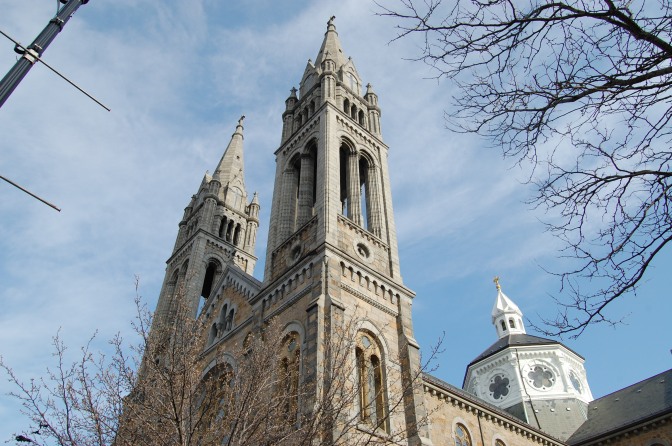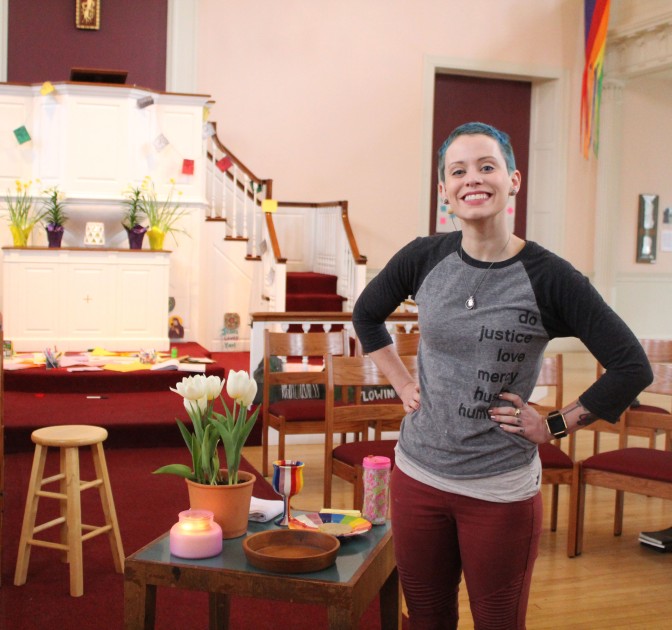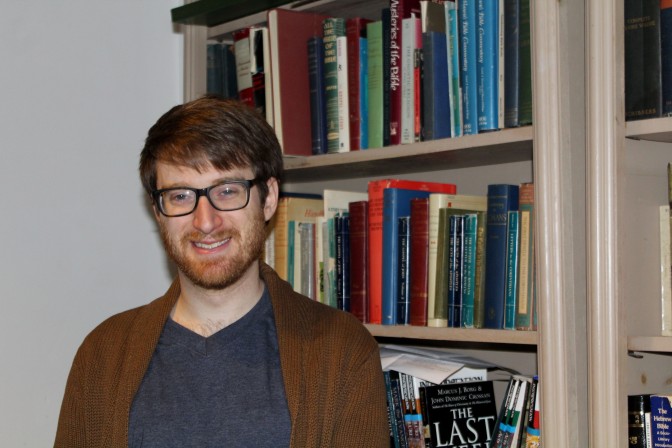Story by Paxtyn Merten
It’s 2:30 p.m. on a Saturday. Though the morning saw some of Boston’s first sun rays since spring began, it is now overcast and a crisp 48 degrees. Stepping through the front doors of the colossal Our Lady of Perpetual Help Catholic Church in Mission Hill provides an escape from both the breeze and the rings of ambulance sirens that echo down the streets of the Longwood medical area.
The basilica’s sanctuary, built to seat hundreds, is empty other than three people near the altar. To the left, a man hunches over rows of candles in red glasses. He rises, makes his way to a pew close to the main entry and settles in with a newspaper. Another woman sits a few rows back from the altar. She stands up, walks to the candles, bows over them for a moment and makes the sign of the cross before walking out.
The third of the church’s inhabitants does not move. She kneels in the front row, posture straight and elbows resting on the front wooden barrier. From 10 rows back, her whispered prayers cannot be heard, and only by standing in front of her bench can one hear the faint but frantic sound of her voice. To know the actual words, you would have to be inside her mind — or God.
Our Lady of Perpetual Help, a historical church dating back to 1878, is open seven days a week for people to visit or wander in. Monday through Saturday the church doors open at 6 a.m. and do not close until 7 p.m., and on Sunday the church hosts four services starting at 9 and into the evening. It’s easy to imagine all churches like this: buildings where people can enter anytime throughout the week to pray or simply sit in peace.

But in Boston, despite its size and bustle, that’s not the case. Whether because of limited funds for facilities, diminishing numbers of parishioners or too few staff members to secure the buildings, most churches across the city are only open to the public for limited periods of time throughout the week, and some only for Sunday services. Even churches with major historical ties, like the United Methodist Old West Church in Government Center — where the phrase “no taxation without representation” was coined — the doors are only open a little bit before and for a short while after Sunday services.
Finding these doors locked, people lose the opportunity to have individual experiences of spirituality. Michael Crosbie, editor of Faith & Form, an interfaith journal of religion, art and architecture, said if a church building is only open during services, potential visitors may not feel comfortable entering. But if these spaces are open outside of services, it provides an opportunity for those people to enter and have their moment — something he said is an important reason for churches and other sacred buildings to exist.
“Sacred spaces are really important for people because they’re just unlike the kinds of spaces that we normally have in our lives,” Crosbie said. “Some people find them really important just to be a place apart where they can kind of go and collect their thoughts or meditate or contemplate or pray. I think sacred spaces fulfill a really important human need.”
However, Crosbie said a lot of faith communities are struggling with how to welcome visitors and make their buildings more open. If the buildings don’t encourage people to interact with them, he said people stop coming. Richard Elliott, director of campus operations at Park Street Church, an evangelical congregation located downtown between the Boston Common and the Granary Burying Ground, said churches across Massachusetts are either closed permanently or increasingly isolated among their own congregations.
“Too many churches and ourselves,” Elliott said, “are guilty of wanting to be an island unto themselves.” Elliott, 48, used to work in carpentry across western Massachusetts and has a lifetime of experience with historic buildings and structures. “I can take you through town after town where every single church is a shuttered historical society, has been converted into a mansion, has turned into a dinner theatre, and very few of them are open,” he said.
Park Street Church owns four adjacent buildings at 0-3 Park St. including the main sanctuary, administrative building, classrooms for a preschool and kindergarten, offices and meeting spaces. The church’s second function as a school sets the pace for public access: The building is nearly always closed during the week for the children’s security. Others, like Old West, don’t have the volunteer base or staff capacity to remain open for hopeful visitors.
On the other hand, Our Lady of Perpetual Help, a basilica and a shrine, opens to the public every day because they have a large enough staff to do so. “The doors are always open,” said Father Joseph Tizio, a pastor at the basilica. “This has always been a place people come during the day.”
Tizio, who has been a priest for 43 years, emphasized that because there are so many hospitals nearby, the basilica is a place many people come to pray for loved ones who are ill — including former Sen. Edward Kennedy (D-Mass.) who prayed at the basilica both when his son had cancer and when he underwent treatment for the disease until his death in 2009.
Every church makes an effort to be open and accessible, Tizio said, but their ability to do so depends on their location, staff and funding. What’s more, he said churches make efforts to be open to the community by means other than throwing their doors open. “It’s just to be accessible in their own way,” he said. “I’ve never been to a church that didn’t want to be accessible because this is what they’re here for.”
***
A growing percentage of the American population that does not identify with any single religious group means more churches are closing their doors. Pew Research Center reported in 2015 that nearly 23 percent of Americans are unaffiliated with any religion. In Boston, that percentage was at 33. Elliott and other church leaders say they see more churches close down every year.
“Churches right now are struggling to literally stay open,” said Sara Gerrard, the sole pastor at Old West Church, where congregants sit in a small circle of chairs and Gerrard gives her sermon sitting cross-legged on a wood stool. “People are coming to churches as museums, not as religious experiences. Which is fine, but that’s a shift in perspective that doesn’t exactly generate income.”

For those that are still open, the involvement of the congregation plays largely into how accessible they can be to the surrounding community in terms of open doors, hosting events and community outreach.
Vonya Perham is the office manager at Boston Seventh-day Adventist Temple on Jersey Street, a modest building that sits among convenience shops and apartment complexes just blocks away from the famous Fenway Park. Perham, who has been with the church since the 1970s, said it is not as involved with the community as it was in the late-1980s and 1990s. At the time, the head pastor made significant efforts to work within the community, including serving hot meals once a week in the Boston Common.
“When I moved back in 2012, they had fallen away from the community things and were not as accessible,” she said, tearing a bite off of her breakfast muffin. Pastors at the temple only wind up staying for between three and seven years, she said, thus they can only influence change on their communities for a certain period of time. It is primarily up to the congregation to ensure they remain open to the public, Perham said.
“The pastor should be a leader in that, but the pastor can’t do it all,” she said. “A lot depends on the membership and how supportive the membership is of any given program.”
Location can also make it difficult for churches to be publicly available. The Community Church of Boston, a Unitarian church located in Copley Square, struggles to remain accessible in an urban center. The church, which sits above a restaurant storefront in a typical multi-use building, is only open Sundays slightly before services until a couple hours after. Interim administrator, guitar player and music director Dean Stevens said security is a big issue.
“I play in churches in New Hampshire and Maine and they tell me that they never lock their door,” Stevens said. “Unfortunately this is Copley Square and there’s a little bit different reality.” Between the homeless population centered in Copley and customers at a neighboring liquor store, Stevens said leaving the church building unattended could spell trouble. “I don’t imagine that any kind of urban church would have its doors open without having somebody on location.”
Perham said before they had an alarm system installed, there were cases of theft at the church, and she has been at other churches that were vandalized.
“One of our members lost a bike and a laptop right out of the building,” Perham said. “So we tend to keep the doors locked. We have alarms. It puts a hitch in how much we’d like to be open, you know. We can’t afford theft. It does restrict accessibility.”
Gerrard says Old West Church doesn’t have enough funding to be open during the week. But even if they did have additional funds, she’s not sure that’s what they’d spend it on: The church community has a lot of needs, and access for members of the public who are often tourists hoping to check out a neat historical building does not top the list.
***
The fact is, the open-door policy is largely a Catholic tradition, considering many Catholic churches have clergy living on-site in rectories.
“Of course the sort of Catholic piety around the use of churches during the day is a little different than the sort of Protestant one,” said Ben Crosby, the parish administrator and building manager at Church of the Cross, an immense Anglican church in Copley. “It’s something that I would love to see more churches do.”
Gerrard said the idea that all churches are open to this extent, or should be, is a sustained myth that is likely most common among people who don’t go to church and who don’t know the differences between denominations. “It doesn’t match where people are societally with attending church,” she said as she fiddled with her computer to print that week’s church newsletter. “Especially in Boston there’s this culture of Catholicism but there’s not a practice of it, and in all denominations there’s not a follow-through of education about what that means.”
Still, most church staffs have a desire to open their doors more to the public, and many church leaders say they wish more churches were able to keep their doors open. “I always get a little sad if I’m visiting a place and walk up to a church door and have it locked,” Crosby, 26, said. “But I think it also is a real financial commitment to hire people, or a substantial commitment of your volunteer base to staff it for free.”
Michael Crosbie, the Faith & Form editor and a professor of architecture at the University of Hartford, said more people are feeling the desire to visit these places. In Europe over the past decade, he said cathedrals in particular have become hot spots for tourists across the continent. But even in their own neighborhoods, people sometimes look to churches when they desire relief from their day-to-day existence.
“There’s this visual and audio noise coming into our lives all the time, and sometimes we feel like we can’t stop it,” Crosbie said. “These buildings are kind of the antithesis of that in a way: They’re a place where you’re supposed to be quiet and you’re supposed to be peaceful … and if the door’s open you can go inside and people will let you just sit there quietly. There’s not a whole lot of other buildings that you can do that in.”
Several churches across Boston that lack the space, volunteer base or funding to open their buildings as places of solace throughout the week facilitate small community groups in people’s homes for congregation members to experience spirituality in an everyday setting. At the Seventh-Day Adventist Temple last summer, the weekly bulletin encouraged congregation members to sit on the building’s steps during their lunch break to welcome passersby. And some churches cultivate outdoor areas where people can be in their spaces, such as produce gardens.
But other institutions have looked for ways to open their sanctuaries more to provide sacred spaces to strangers who may wish to connect with their spirituality outside of Sunday services. Over the past four years, Church of the Cross has succeeded to do this, welcoming between 16,000 and 20,000 visitors a year through their open sanctuary program.
“A couple years ago, under my predecessor, there was a sense that it really was a problem that this church saw a lot of use Sunday morning — and other parts of our physical building saw use throughout the week — but the sanctuary itself was largely closed to the public throughout the week except for by appointment,” said Crosby, who has been with the church for two years.
So they set up the open sanctuary program, which runs eight to nine months a year and allows the church sanctuary to be open up to seven days a week, and usually at least five or six. “In general, the idea is these are times there aren’t other events, there really is just a time to come in and experience the space,” Crosby said.

The church does not ask an admission fee, but requests donations during the program hours in order to pay for the staff necessary to maintain it. And it works: Donations from open sanctuary visitors are able to fund the program entirely.
Last season, when the program was in full swing, the church was open Sundays 12:30-4:30 p.m. and from 11 a.m. to 3 p.m. every other day of the week except Tuesday. A majority of the visitors are tourists, but some do wander in just to sit in peace, Crosby said.
“I think it was just sort of a deeper living into our sense that we are here not just for us,” he said, “but to serve the community in which we exist in a variety of ways, and opening up our space is part of that.”

